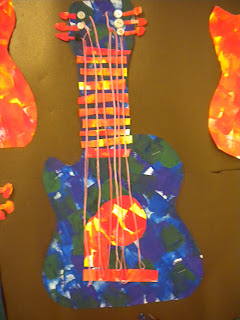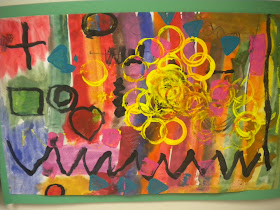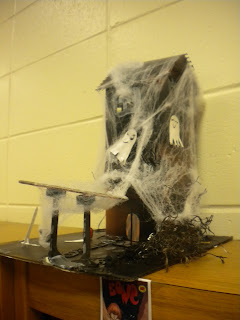2nd Graders read the story the Pout Pout Fish. We then made a stencil drawing of a Pout Pout Fish on manilla railroad board paper. Students cut it and had a tracer for their slab fish. We reviewed clay vocabulary, slab, score, and slip. We also discussed what texture meant, both actual and visual texture. Students rolled out their slab of clay, traced their fish shape on it and used cutting tools to cut it out. Students then used stamps and a drawing tool to create texture and details on their fish. From their left over slab they created the eyes, mouth and fin and used proper attaching techniques. Lastly, they glazed using Magic Glazes. Easy clay in a day project that goes over beginning techniques and vocabulary.
Wednesday, December 9, 2015
Clay Pout Pout Fish
2nd Graders read the story the Pout Pout Fish. We then made a stencil drawing of a Pout Pout Fish on manilla railroad board paper. Students cut it and had a tracer for their slab fish. We reviewed clay vocabulary, slab, score, and slip. We also discussed what texture meant, both actual and visual texture. Students rolled out their slab of clay, traced their fish shape on it and used cutting tools to cut it out. Students then used stamps and a drawing tool to create texture and details on their fish. From their left over slab they created the eyes, mouth and fin and used proper attaching techniques. Lastly, they glazed using Magic Glazes. Easy clay in a day project that goes over beginning techniques and vocabulary.
Tuesday, December 1, 2015
Guitars
4th
graders learned about the city of Paracho, Mexico; a city located just 2 hours
south of Guadalajara. The interesting thing about the city of Paracho is that
it is said to have more guitar-making artisans within its population of
approximately 17,000 people, than in the entire United States!
Guitar
making is a tradition passed down from generation to generation and is a source
of income for the people of Paracho. The guitar-making also attracts a bit of
tourism for the city as it hosts a Guitar Festival each year.
Students
learned about the parts of a guitar through Smart Board matching game. Next
they reviewed the warm and cool colors of the color wheel. Students choose one
color scheme and sponge painted their paper with those colors. They then used
the opposite color scheme to add the details of the guitar.
***Wonderful lesson and background info from Art with Mrs. Nguyen blog***
Pattern Harvest Corn
I really try to work on the basic fine art motor skills and knowledge in First Grade. A lot of the projects might seem very basic, but our kindergartners do not have art class in our district. So a lot of the time I get first graders coming in who don't know much about how to use a scissor properly, or glue correctly, or even how to hold a paintbrush. This lesson was a bit of review and also new information. I also focus quite a bit on proper art vocabulary. No hamburger or hot dog folds in my art class, we say vertical and horizontal. Students first looked at real harvest corn and we discussed what types of lines we saw and any colors that repeated. First we drew the shape of our corn using curved lines and vertical lines. Next we used three fingers to measure our horizontal lines going across so that they would be somewhat evenly spaced out. We outlined our drawing in Sharpie. Next we talked about pattern. I always tell my students the key to making a pattern is that it has to REPEAT! I give them tons of examples and then always let them complete the pattern. I even make a pattern out of the class using a boy/girl pattern. Someone always figures it out and they love that. Students choose 2-5 colors to make a pattern on their Harvest corn. Paper towels were ripped, twisted and glued on for the stalks.
Matisse Fish Bowls
Second graders
have been studying the French artist Henri Matisse. They learned that when he
was younger he had no interest in art. Mostly because they didn’t have art
class in school back then! When Matisse was a little older, he came down with
appendicitis. During his recovery his mother got him some art supplies for
something to do. He fell in love with painting and art. He decided he wanted to
become an artist. He first loved to paint and used bright colors and vivid
patterns. As he got older, his back hurt too much to paint. He still had a
passion for art and didn’t want to stop creating, so he invented his own style
of art which he called “drawing with scissors.” This allowed him to sit in his
wheelchair and still make art by cutting and gluing. This kind of art is called
collage. Second grade artists created their own depiction of one of Matisse’s
famous paintings, Goldfish. Students painted, drew, cut, and glued to make
their masterpieces!
***Lesson Idea from Artolazzi:)***
Blue Dog
Third graders learned about the
American artist George Rodrigue. Rodrigue is from Louisiana. Rodrigue shot to
fame for painting “BLUE DOG”. Blue Dog was inspired from a childhood tale of a
werewolf dog Rordrigue heard as a child and from his family dog, Tiffany. Blue
Dog has popped up in all sorts of modern pop culture. Where have you seen Blue
Dog?
( I have a lot of Hispanic students at my school and I love how they always sneak the love of their culture into art projects. The Mexican flag always seems to find its way into art projects. And I love the Blue Dog painted all orange from eating Takis. If you've eaten Takis, (a Mexican type of chip like Cheetohs), they make a huge orange mess. I love how that students covered his Blue Dog in orange paint)
Abstract Kandinsky Paintings
First graders learned about the
abstract artist Wassily Kandinsky. Students learned that abstract art is art
that often includes lines, shapes, and color, but isn’t always an exact picture
of something. Everyone can look at abstract art and see something different!
Students first drew all different types lines with Sharpie. Then they used oil
pastel to make shapes. Next they painted the background with watercolor. They
then stamped various circle shapes using the bright colors, and lastly outlined
in black to create emphasis. The first graders had three learning targets throughout this project:
I can color with control.
I can trace slowly and carefully and stay on the original lines.
I can paint using the technique demonstrated by the teacher.
They did a great job and they turned out beautiful!
Thursday, October 29, 2015
FLW Spooky House
The 4th grade students studied Architecture. We talked about what the architect Frank Lloyd Wright and learned what an architect does. Students were able to learn what an arch, vault, cantilever and a post and lintel are. Students had to use at least two of these characteristics when they were designing their house sculptures and had to identify them. Students were able to learn what a sculpture is and we talked about the various materials a sculpture can be made out of. Students worked really hard using various recycled materials to create a unique haunted house sculpture. Finally students were able to add patterns using metallic paint to complete their sculptures.
Day of the Dead Skulls
Day of the Dead (Spanish: Día de los Muertos) is a holiday celebrated by many in Mexico and by some Mexican Americans living in the United States. The holiday focuses on gatherings of family and friends to pray for and remember friends and family members who have died. Traditions connected with the holiday include building private altars honoring the deceased using sugar skulls, marigolds, and the favorite foods and beverages of the departed and visiting graves with these as gifts. The Day of the Dead is a time of celebration where eating and partying are common.
Fifth graders learned about the Mexican holiday, Day of the Dead through two short videos and a classroom discussion. We drew our skulls from printed handouts. Fifth graders were encouraged to make their skull look festive by creating a hat and adding other details to their drawing.
Tree Silhouettes
Third graders learned that a silhouette is the image of an object or scene represented as a solid shape, single color, and it's edges matching the outline of the subject.
In class we did a Smartboard activity where the third graders had to guess the silhouette of a famous person- can you name all the silhouettes?
Students used chalk pastel to create the sky and moon background. Next they learned a different approach to painting a fall tree by using a piece of cardboard for their paintbrush. Students used the cardboard to paint in the trunk and thick branches of the tree by using a scraping motion, and then skinny branches by using a stamping technique with the cardboard. Students used only one color to create a silhouette- like effect. They did a great job!
Water Color Scarecrows
2nd graders read the story The Little Scarecrow Boy by Margaret Wise Brown. Students then reviewed shapes, vertical, and horizontal lines. By knowing these art words and being able to draw them, students were able to create a wonderful scarecrow drawing. Together, we drew the scarecrow step by step. Students then reviewed how to carefully outline their drawings with oil pastel by staying on top of the original pencil line.
Finally, students used watercolor to paint in their beautiful drawings. We reviewed proper paint techniques and how to hold our paint brushes to have the most control of our paint.
They turned out great! Students did a great job following directions!















































